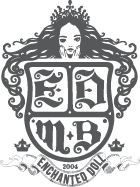Just like a human shoulder, if a doll shoulder is over-rotated inside its socket, it can sometimes dislocate. A spring tension assembly is a rigid “skeleton” inside the porcelain “skin” of a doll. Springs are the “bones” that hold all the limbs together. Just like with our human bones, if you rotate them beyond their design limit, they can dislocate.
One of my collectors over-rotated the shoulder and it popped out during vigorous play with their Enchanted Doll. They asked for my help with reconnecting it, to avoid shipping it back to me across the world, so I made this instructional video for them. I thought others might enjoy this inside look into my assembly nuances.
A rigid, metal spring tension assembly a very different system from the industry standard elastic cord, which is usually used to assemble resin ball jointed dolls. Elastics are not well suited for porcelain ball-jointed dolls for multiple reasons, jerky mechanics being one, and a gradual loss of elasticity due to the aging of rubber, being another. Slackening of elastic tension endangers porcelain dolls, as the limbs become ehh, loosey-goosey… I believe is the proper scientific term.😀
To avoid the aging elastic cord, I designed my own tension system using industrial steel springs, pins and S-hooks. Metal ages much slower than rubber elastic, and in theory, springs should provide consistent tension for many, many decades of use given that they are kept dry.
But no system is perfect. Each one has advantages and drawbacks. The drawback of the metal springs is that it’s more complicated and rigid than elastics. It’s comparable to a human skeleton of bones, in that it has more rotational limitations than the soft elastics inside resin ball-jointed dolls.
To me, the exchange is worth it. Porcelain is such a beautiful and ageless medium if handled with proper care, that I don’t mind a bit of extra finesse it demands. 🤩 What do you think of my system?
